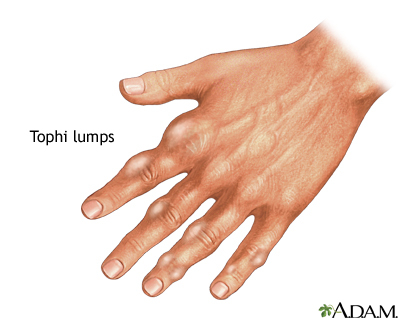Definition
Gout is a type of arthritis. It occurs when uric acid builds up in blood and causes inflammation in the joints.
Acute gout is a painful condition that often affects only one joint. Chronic gout is the repeated episodes of pain and inflammation. More than one joint may be affected.
Alternative Names
Gouty arthritis - acute; Gout - acute; Hyperuricemia; Tophaceous gout; Tophi; Podagra; Gout - chronic; Chronic gout; Acute gout; Acute gouty arthritis
Causes
Gout is caused by having higher-than-normal level of uric acid in your body. This may occur if:
- Your body makes too much uric acid
- Your body has a hard time getting rid of uric acid
When uric acid builds up in the fluid around the joints (synovial fluid), uric acid crystals form. These crystals cause the joint to become inflamed, causing pain, swelling and warmth.
The exact cause is unknown. Gout may run in families. The problem is more common in men, in women after menopause, and people who drink alcohol. As people become older, gout becomes more common.
The condition may also develop in people with:
Gout may occur after taking medicines that interfere with the removal of uric acid from the body. People who take certain medicines, such as hydrochlorothiazide and other water pills, may have a higher level of uric acid in the blood.
Symptoms
Symptoms of acute gout:
- In most cases, only one or a few joints are affected. The big toe, knee, or ankle joints are most often affected. Sometimes many joints become swollen and painful.
- The pain starts suddenly, often during the night. Pain is often severe, described as throbbing, crushing, or excruciating.
- The joint appears warm and red. It is most often very tender and swollen (it hurts to put a sheet or blanket over it).
- There may be a fever.
- The attack may go away in a few days, but may return from time to time. Additional attacks often last longer.
The pain and swelling most often go away after the first attack. Many people will have another attack in the next 6 to 12 months.
Some people may develop chronic gout. This is also called gouty arthritis. This condition can lead to joint damage and loss of motion in the joints. People with chronic gout will have joint pain and other symptoms most of the time.
Deposits of uric acid can form lumps below the skin around joints or other places such as the elbows, fingertips, and ears. The lump is called a tophus, from Latin, meaning a type of stone. Tophi (multiple lumps) can develop after a person has had gout for many years. These lumps may drain chalky material.
Exams and Tests
Tests that may be done include:
A uric acid level in the blood over 7 mg/dL (milligrams per deciliter) is high. But, not everyone with a high uric acid level has gout.
Treatment
Take medicines for gout as soon as you can if you have a new attack.
Take nonsteroidal anti-inflammatory drugs (NSAIDs) such as ibuprofen or indomethacin when symptoms begin. Talk to your health care provider about the correct dose. You will need stronger doses for a few days.
- A prescription medicine called colchicine helps reduce pain, swelling, and inflammation.
- Corticosteroids (such as prednisone) can also be very effective. Corticosteroids can be injected into the joint or taken as a pill. Your provider may inject the inflamed joint with steroids to relieve the pain.
- With attacks of gout in multiple joints an injectable medicine called anakinra (Kineret) may be used.
- The pain often goes away within 12 hours of starting treatment. Most of the time, all pain is gone within 48 hours.
You may need to take daily medicines such as allopurinol (Zyloprim), febuxostat (Uloric) or probenecid (Benemid) to decrease the uric acid level in your blood. Lowering the uric acid to less than 6 mg/dL is needed to prevent deposits of uric acid. If you have visible tophi, the uric acid should be lower than 5 mg/dL.
You may need these medicines if:
- You have several attacks during the same year or your attacks are quite severe.
- You have damage to joints.
- You have tophi.
- You have kidney disease or kidney stones.
Diet and lifestyle changes may help prevent gouty attacks:
- Decrease alcohol, especially beer (some wine may be helpful).
- Lose weight.
- Exercise daily.
- Limit your intake of red meat and sugary beverages.
- Choose healthy foods, such as dairy products, vegetables, nuts, legumes, fruits (less sugary ones), and whole grains.
- Coffee and vitamin C supplements (may help some people).
Outlook (Prognosis)
Proper treatment of acute attacks and lowering uric acid to a level less than 6 mg/dL allows people to live a normal life. However, the acute form of the disease may progress to chronic gout if the high uric acid is not treated adequately.
Possible Complications
Complications may include:
High levels of uric acid in the blood are associated with increased risk of kidney disease. Studies are being done to find out whether lowering uric acid reduces the risk for kidney disease.
When to Contact a Medical Professional
Call your provider if you have symptoms of acute gouty arthritis or if you develop tophi.
Prevention
You may not be able to prevent gout, but you may be able to avoid things that trigger symptoms. Taking medicines to lower uric acid can prevent progression of gout. Over time, your deposits of uric acid will disappear.
References
Dalbeth N. Clinical features and treatment of gout. In: Firestein GS, Budd RC, Gabriel SE, Koretzky GA, McInnes IB, O'Dell JR, eds. Firestein & Kelley's Textbook of Rheumatology. 11th ed. Philadelphia, PA: Elsevier; 2021:chap 101.
Edwards NL. Crystal deposition diseases. In: Goldman L, Schafer AI, eds. Goldman-Cecil Medicine. 26th ed. Philadelphia, PA: Elsevier; 2020:chap 257.
FitzGerald JD, Dalbeth N, Mikuls T, et al. 2020 American College of Rheumatology Guideline for the management of gout. Arthritis Care Res (Hoboken). 2020;72(6):744-760. PMID: 32391934 pubmed.ncbi.nlm.nih.gov/32391934/.
FitzGerald JD, Neogi T, Choi HK. Editorial: do not let gout apathy lead to gouty arthropathy. Arthritis Rheumatol. 2017;69(3):479-482. PMID: 28002890 pubmed.ncbi.nlm.nih.gov/28002890/.
Liew JW, Gardner GC. Use of anakinra in hospitalized patients with crystal-associated arthritis. J Rheumatol. 2019;46(10)1345-1349. PMID: 30647192 pubmed.ncbi.nlm.nih.gov/30647192/.




